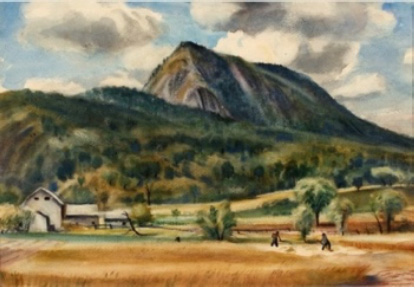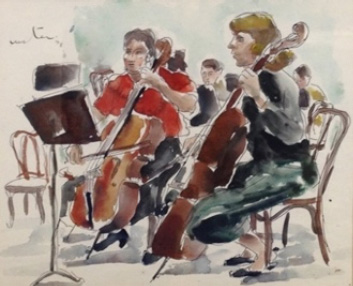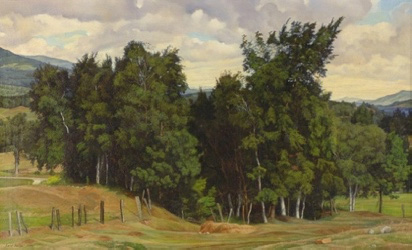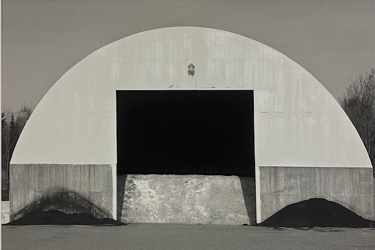EXPLORE OURPermanent Collection
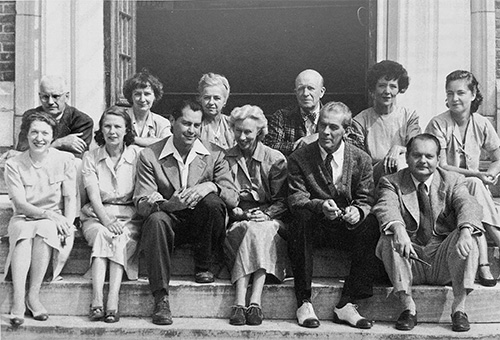
In the early decades of the 20th century, a newly formed artist collective calling themselves the Dorset Painters held exhibitions of their work at the Town Hall. The group included Edwin B. Child, Francis Dixon, Wallace W. Fahnestock, John Lillie, and Herbert Meyer. The first exhibitions were held in 1922 and 1924 and by 1926 the group held regular annual exhibitions. Within a few years, a Manchester-based group gathered to exhibit their work to increasingly diverse numbers of residents and “summer people” on the green in Manchester Village and at the gymnasium at Burr & Burton Seminary. By the end of 1929, the Southern Vermont Artists, using this signature identity for the first time, held its annual exhibition in the Equinox Pavilion. SVA incorporated as a membership association in 1933 and in 1950, with the acquisition of the 120-acre Webster Estate on West Road, reorganized as Southern Vermont Art Center. Nestled in the foothills of Mount Equinox, the property included Yester House, a 28-room Colonial Revival home, as well as forested acreage, parklands, and seven trout ponds. Designed by the architectural firm Murphy and Dana of New York City, Yester House, built in 1916, is listed on the National Register of Historic Places.
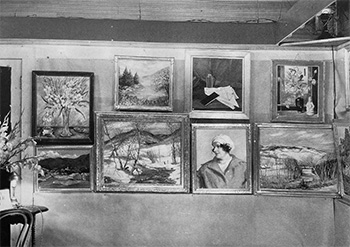
Although Mrs. Webster had intended for her home to become a museum featuring her collection of antiques, paintings, and extensive collection of handblown Vermont glassware, her collection was sold after her death in 1947. With the purchase of the property, the founders remodeled Yester House to include ten distinct galleries for summer exhibitions. By 1951, promoting the advancement of arts and culture in Southern Vermont, the founders opened their membership to the public. The trustees reincorporated as a 501(c)3 nonprofit in May 1952.
Few of the artists who journeyed to Southern Vermont for the summer season considered “the Manchester experiment” an artist colony and only a handful of members contemplated the development of a permanent art collection or museum to house it. Yet, advances during the Modern Era in the fields of science, art, technology, and communication had already prompted a redefinition of American values, traditions, and identities contributing to unparalleled support for public institutions, including park systems, schools, and museums. Innovation accelerated the pace and prospects of daily life for greater numbers of Americans. With access to convenient modes of travel, the fusion of industry, technology, and art brought artists, patrons, and tourists into the pastoral landscapes of New England. Between 1830 and 1920 an estimated three thousand professional artists participated in an annual summer exodus from the major urban centers to the countryside, residing for varying lengths of time in over 80 rural and seaside communities.
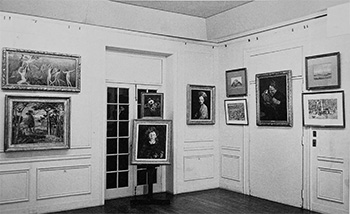
SVAC’s transition from emergent art colony to evolving arts institution, including a permanent collection, reflected the founding members’ intention to coalesce the arts, culture, cooperative education, and exhibition opportunities.
Today, the Permanent Collection is comprised of over 1,000 paintings, sculpture, and works on paper by prominent American Regionalists including Reginald Marsh, Guy Pene duBois, Harriette Gowen Miller, Ogden Pleissner, Jay Hall Connaway, Marion Huse, Luigi Lucioni, Bernadine Custer Sharp, and Robert Strong Woodward among others.
SVAC’s online database will continue to grow with additional records and ongoing research. We encourage visitors to check back often for updates!
Featured Collections
TIPS FOR SEARCHING
KEYWORD
Keyword Search allows you to perform a general search across multiple fields for any catalog records online. Keyword searches use OR as the default connector between words (e.g. a search for Art Colony will return records associated with Art OR Colony). If you want to find records where both keywords are found, type in AND between the two words. To search for a specific phrase, be sure to put the phrase within quotes (e.g. “Yester House”). You can also use the asterisk (*) as a wildcard (e.g. a search for histor* would come up with records containing history, histories, historical, etc.). Searches are not case sensitive. Click here to search by keyword.
ADVANCED
Advanced Search can help you be more specific with your search. You can search for a word or phrase within a particular search category or use multiple categories to further narrow down your search results. For example, searching Arkell in the People field will bring up any records associated with a member of the Arkell family, without having to sift through black & white photographs. You can also search People and Creator records through Advanced Search. Phrase searching with quotes and use of wildcards (*) are available in Advanced Search.
RANDOM IMAGES
Random Images is a great way to browse the collection. Each Random Images page displays a random assortment of images from the records online. If something piques your interest, click the thumbnail to view a larger version of the image. Click here to view random images.
CATALOG SEARCHES
The individual catalog searches can also help narrow down your search, by only searching with a selected catalog. If you only want to search for Objects, click here (the Objects button) and type in your keyword(s) or phrase. You can also browse records within that catalog without performing a search. Phrase searching, wildcards (*) as well as AND/OR statements are available when performing catalog searches.
PEOPLE
If you are interested in searching for the People and Creators associated with the collection, People provides a way to browse and search these records. Click here to search People and Creators.

